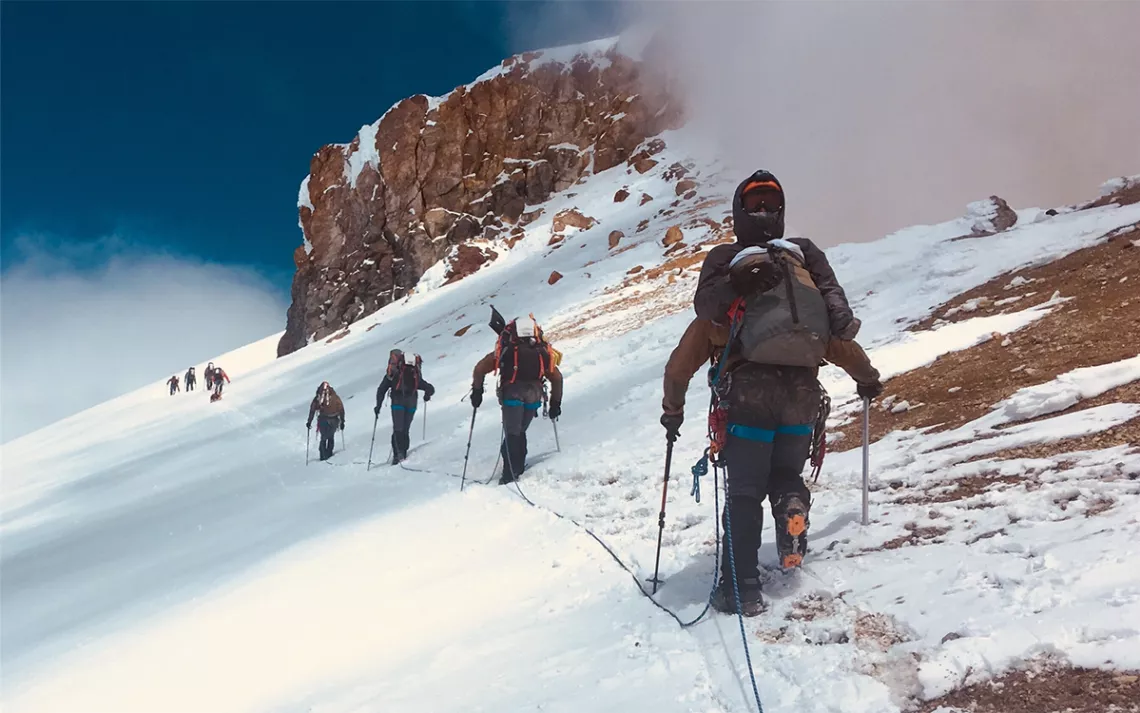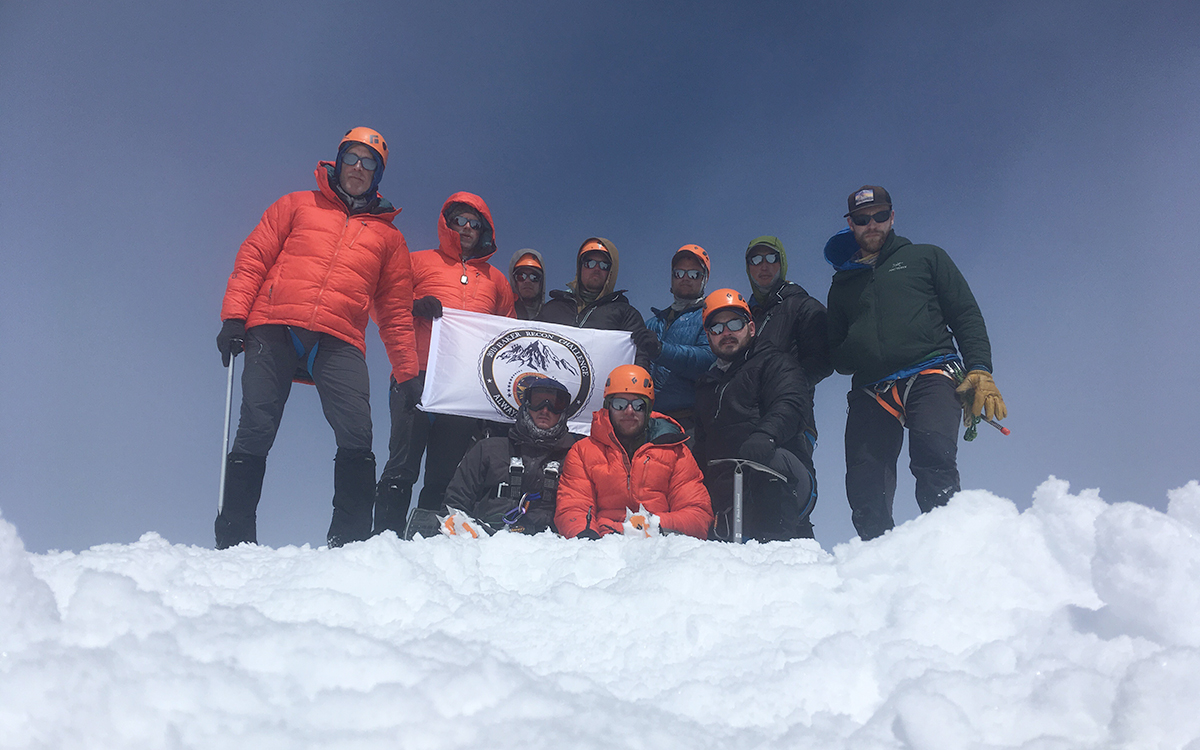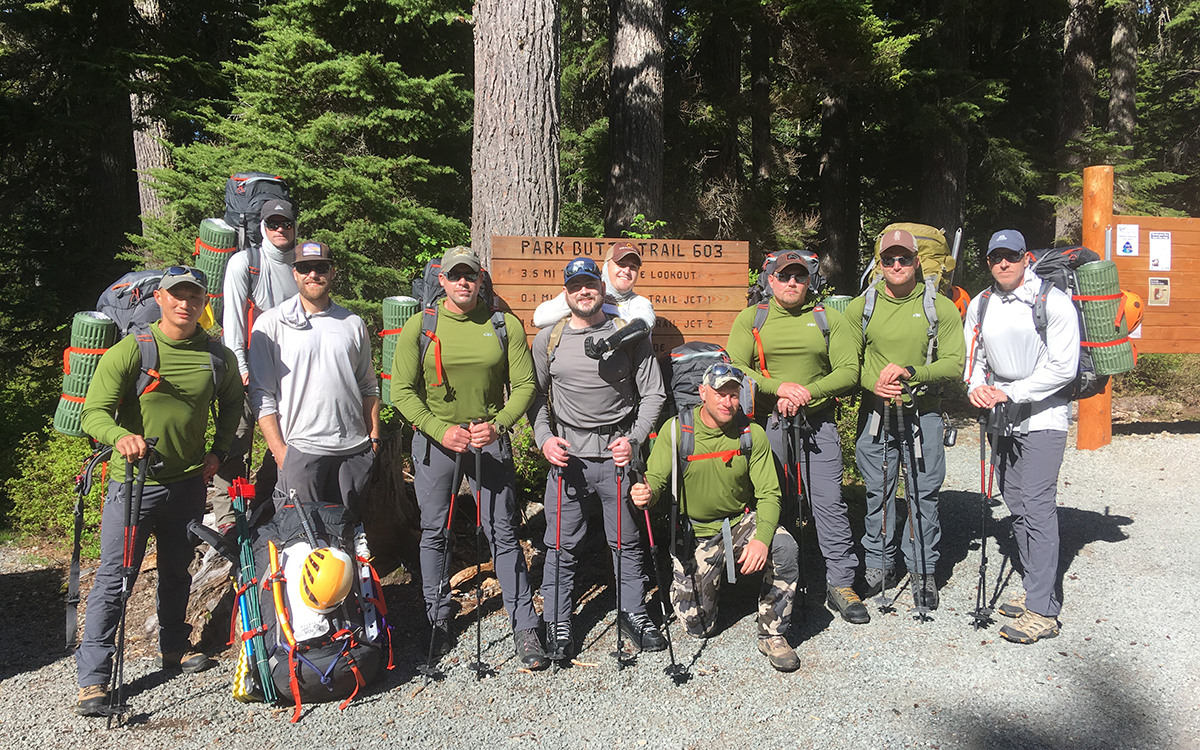Triple Amputee Todd Love Climbs Mountains With Help From Friends
A veteran and his fellow marines rediscover the joy of a shared mission

Photos courtesy of David Jarvis and Andrew Dyer
Just 30 feet short of the summit of Washington State’s Mt. Baker, Todd Love was on his own.
Not literally of course—nine of his closest friends surrounded him and cheered him on as he struggled toward the summit. But as a triple amputee, Love made the final push under his own power, arms propelling his body through the cold and slippery snow.
Love and his team of climbers were among the hundreds to reach Baker’s 10,781-foot peak last summer, but their climb was nothing like that of the usual weekend warriors.
In 2010, while on deployment in Afghanistan, Love stepped on an improvised explosive device, losing his left arm below the elbow and both his legs from just below the waist. Now he was climbing Mt Baker with fellow marines who had been with him on that life-altering day and who had endured both visible and invisible wounds of their own. For Love and his team, climbing Mt. Baker was a chance to move forward.
To hear it from Love, it was almost predetermined that he would become a marine.
“My dad was a marine and his dad was a marine as well. We used to joke around and tell people I thought a lot about joining the air force because of that,” Love says. “But it just felt right.”
For his 2010 deployment, Love was sent to the Sangin Valley in Afghanistan as part of First Platoon, Bravo Company, First Reconnaissance Battalion. That’s where he met Andrew Dyer.
Dyer, too, grew up feeling his fate as a marine was a foregone conclusion.
“I was in middle school when 9/11 happened. I was actually home sick that day, so I watched everything play out on TV,” he remembers. “I was kind of a true believer, if you will, when I joined. I wanted to go and fight terrorists.”

The Sangin Valley was not an easy place to be stationed. Already in one of the deadliest regions in the country, Bravo Company was located at the outer edges of the range of medical evacuation helicopters. Survival chances diminish greatly if a patient can’t get to a hospital within an hour—a trip for Bravo Company was 45 minutes one-way.
The company was on its first of two missions in Sangin in October, running regular patrols through small towns in search of the Taliban. On the morning of October 25, Love was leading a group of soldiers through an abandoned town while Dyer and others worked through a nearby field. As Love recalls, it was pretty routine.
“I remember that morning, and I remember doing my job,” he says. “I remember searching a building, and no one had lived there for a long time. All the plants inside were growing wild and crazy. That stood out to me as not a good sign.”
Out in the nearby field, Dyer heard the explosion and immediately found himself and the rest of his immediate team surrounded by gunfire. When the Medevac helicopter finally arrived, Dyer watched at least six rocket-propelled grenades launch and narrowly miss the chopper.
“I still can’t believe that they landed in the midst of all that,” he says.


Love and another soldier, Kyle Thompson, who had been patrolling with Love, were flown out to the closest hospital (Thompson lost an eye in the blast). Eventually, the firefight settled down enough for the rest of the battalion to return to their base, where Dyer and others received word that Love and Thompson had survived the trip. There was nothing to do but try and wind down and prepare mentally for the next round of patrols the following day. But for Dyer, Love’s absence was especially jarring. The two usually spent their evenings together.
“[Love] and I both liked sleeping outside for some reason. The night before he got blown up, we were basically sleeping with my head at his feet. We'd plan our missions and go to bed and wake up next to each other every morning,” Dyer says.
The explosion meant the end of the deployment for Love and Thompson, but the rest of the platoon still had two months of life-as-usual in Sangin. By December, when their deployment ended, more than 20 Purple Hearts had been awarded to the company, and no marine had suffered a fatal casualty, but, Dyer says, he and the rest of the company felt “hardened” after the attack that injured Love and Thompson.
“Going home was hard,” Dyer recalls. “I had been in active gunfights within a month of getting home.”
For Love, there was no going home yet. Eventually, he was transported to a hospital in Germany, where he underwent the long, slow process of recovery. For a while, the extent of his injuries wasn’t clear to him—he was just happy to be alive. He knew one hand was banged up, but he thought he could still feel and move his legs. It was only when he reached down one day to try and touch his legs that he realized they were completely gone.
“My hand just hit the hospital bed,” he said. “I looked up at my dad, and I was shocked.”
Gradually, Love adjusted to his new reality. He underwent intensive physical therapy and within three months, he was skiing on a sit-ski—an adaptive set of skis designed for people with disabilities.
Learning to sit-ski was a game-changer.
“I’m an athlete. I’ve always been an athlete. That part of my identity felt like it died when I got hurt, but then I got into skiing, and it woke everything back up,” Love says. "That was one of the biggest eye-openers for me. Like, 'Holy shit, there's a lot of fun and cool things you can do in life despite being in a wheelchair.' I didn’t know that things like that even existed.”
After skiing, Love kept upping the ante, participating with fellow marines and family in Spartan Races, where he’d alternate between “running” on his hand and prosthetic arm and riding on the backs of his friends. He even tried skydiving, freefalling in a custom harness designed for a person without legs.
Then during a 2018 platoon reunion, Love and Dyer started tossing around the idea of bagging the peak of a Cascade volcano.
After a second deployment ended in 2012, Dyer had bounced around different parts of the country before landing in the Pacific Northwest, where he started climbing and skiing. As part of a G.I. Bill program, he learned to guide with Alpine Ascents Institute and spent a winter ski patrolling.
As Dyer sees it, the soft skills he developed as a marine translate well to the mountains—“like being able to analyze and interpret risk and risk mitigation,” he says. Mountaineering, he thinks, is about as close to combat tours as it gets in civilian life. Teamwork is everything, the stakes are higher, and mistakes can be fatal.
Love, Dyer, and eight other fellow marines decided they would summit Mt. Baker, but they had a number of obstacles to overcome before they set foot on the mountain. One was funding for the trip, which required gear rentals, food, lodging, and travel for the veterans, who had all scattered to different corners of the country.
David Jarvis, who was platoon sergeant during the 2010 deployment in Sangin, set himself to the task of fundraising. Now the executive director of the Force Recon Association—a nonprofit that provides reconnaissance veterans with scholarships and other forms of support—he set a lofty goal of raising $100,000. Force Recon advertised the climbing trip on a dedicated website and auctioned off items donated during the National Shooting Sports Foundation’s annual Shot Show, with two auctions bringing in $20,000 and $35,000 each.
“We ended up blowing it out of the water,” Jarvis says. Of the $100,000 raised, about $20,000 went toward the climbing team, while more than $70,000 went back into Force Recon to help others in the reconnaissance community.
The next step was figuring out how to get Love up the mountain’s steep, crevassed terrain. The team eventually settled on a combination of pulling him in a sled and carrying him on their backs and were able to have a backpack custom made for this purpose.

On June 4, the group of 10 began their ascent of Mt. Baker via the Easton Glacier, taking turns towing Love on his sled. They spent the next two days at base camp, practicing crevasse rescue skills, watching the weather, and enjoying one another’s company. Then a storm blew in just before their planned summit push on June 5, forcing them to wait a day. The following morning, the group was greeted with clear skies, and together they set off before sunrise.
Strapped into his rucksack, Love was lifted onto Thompson’s back, and they began to ascend the steep Roman Wall, which lies just before the summit, a mostly flat expanse that rises about 30 feet at its peak.
As the climb progressed, Love found it increasingly difficult to stay warm inside his pack. His carbon-fiber prosthetic arm was getting too cold to wear, and he had to contend with the snow that had been accidentally kicked into his pack. He began to worry that just by being so high on the mountain, he was putting his teammates in danger, and it occurred to him that he might have to call the climb off.
Just as the team reached the last 30 feet, Love got out of the backpack to climb the rest of the way on his own. The going was tough: “Every time I would take a step up, I would slide back like two steps,” Love says.
When he finally reached the top, he and his teammates were elated.
Altogether, summiting the mountain took an exhausting 14.5 hours; the entire trip took six days. According to Jarvis, the climb wasn’t about Love or any one person but about the bond the fellow marines share. Adventures like this one, he says, are a way to build a new legacy together.
Love agrees. “What we did in Afghanistan, looking back, we were so good at it,” Love said. “We were a good team, and we worked really well together. Climbing Mt. Baker gave us that team again. We were working together to accomplish a mission. I’ll never forget that.”
 The Magazine of The Sierra Club
The Magazine of The Sierra Club



